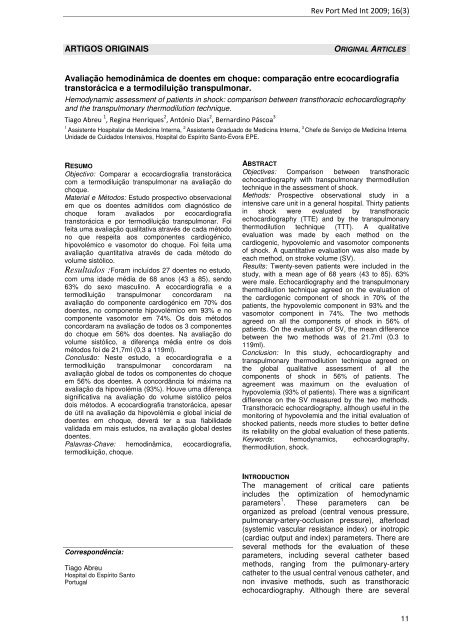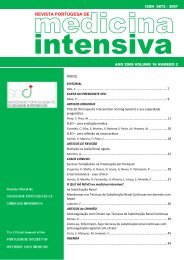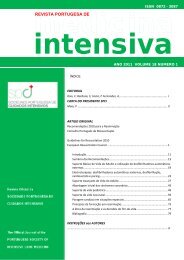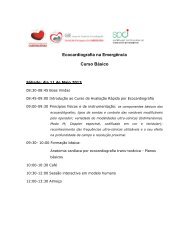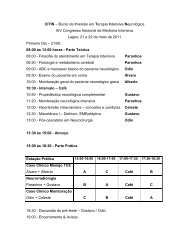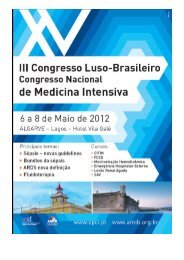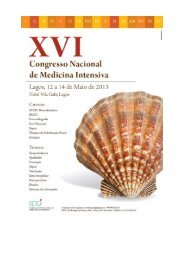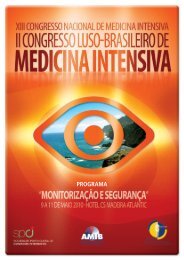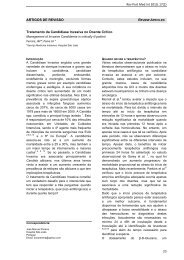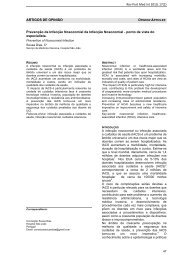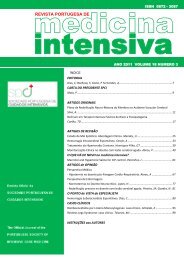Dezembro de 2009 - Vol 16 numero 3 - Sociedade Portuguesa de ...
Dezembro de 2009 - Vol 16 numero 3 - Sociedade Portuguesa de ...
Dezembro de 2009 - Vol 16 numero 3 - Sociedade Portuguesa de ...
You also want an ePaper? Increase the reach of your titles
YUMPU automatically turns print PDFs into web optimized ePapers that Google loves.
Rev Port Med Int <strong>2009</strong>; <strong>16</strong>(3)<br />
ARTIGOS ORIGINAIS<br />
ORIGINAL ARTICLES<br />
Avaliação hemodinâmica <strong>de</strong> doentes em choque: comparação entre ecocardiografia<br />
transtorácica e a termodiluição transpulmonar.<br />
Hemodynamic assessment of patients in shock: comparison between transthoracic echocardiography<br />
and the transpulmonary thermodilution technique.<br />
Tiago Abreu 1 , Regina Henriques 2 , António Dias 2 , Bernardino Páscoa 3<br />
1<br />
Assistente Hospitalar <strong>de</strong> Medicina Interna, 2 Assistente Graduado <strong>de</strong> Medicina Interna, 3 Chefe <strong>de</strong> Serviço <strong>de</strong> Medicina Interna<br />
Unida<strong>de</strong> <strong>de</strong> Cuidados Intensivos, Hospital do Espírito Santo-Évora EPE.<br />
RESUMO<br />
Objectivo: Comparar a ecocardiografia transtorácica<br />
com a termodiluição transpulmonar na avaliação do<br />
choque.<br />
Material e Métodos: Estudo prospectivo observacional<br />
em que os doentes admitidos com diagnóstico <strong>de</strong><br />
choque foram avaliados por ecocardiografia<br />
transtorácica e por termodiluição transpulmonar. Foi<br />
feita uma avaliação qualitativa através <strong>de</strong> cada método<br />
no que respeita aos componentes cardiogénico,<br />
hipovolémico e vasomotor do choque. Foi feita uma<br />
avaliação quantitativa através <strong>de</strong> cada método do<br />
volume sistólico.<br />
Resultados :Foram incluídos 27 doentes no estudo,<br />
com uma ida<strong>de</strong> média <strong>de</strong> 68 anos (43 a 85), sendo<br />
63% do sexo masculino. A ecocardiografia e a<br />
termodiluição transpulmonar concordaram na<br />
avaliação do componente cardiogénico em 70% dos<br />
doentes, no componente hipovolémico em 93% e no<br />
componente vasomotor em 74%. Os dois métodos<br />
concordaram na avaliação <strong>de</strong> todos os 3 componentes<br />
do choque em 56% dos doentes. Na avaliação do<br />
volume sistólico, a diferença média entre os dois<br />
métodos foi <strong>de</strong> 21,7ml (0,3 a 119ml).<br />
Conclusão: Neste estudo, a ecocardiografia e a<br />
termodiluição transpulmonar concordaram na<br />
avaliação global <strong>de</strong> todos os componentes do choque<br />
em 56% dos doentes. A concordância foi máxima na<br />
avaliação da hipovolémia (93%). Houve uma diferença<br />
significativa na avaliação do volume sistólico pelos<br />
dois métodos. A ecocardiografia transtorácica, apesar<br />
<strong>de</strong> útil na avaliação da hipovolémia e global inicial <strong>de</strong><br />
doentes em choque, <strong>de</strong>verá ter a sua fiabilida<strong>de</strong><br />
validada em mais estudos, na avaliação global <strong>de</strong>stes<br />
doentes.<br />
Palavras-Chave: hemodinâmica, ecocardiografia,<br />
termodiluição, choque.<br />
ABSTRACT<br />
Objectives: Comparison between transthoracic<br />
echocardiography with transpulmonary thermodilution<br />
technique in the assessment of shock.<br />
Methods: Prospective observational study in a<br />
intensive care unit in a general hospital. Thirty patients<br />
in shock were evaluated by transthoracic<br />
echocardiography (TTE) and by the transpulmonary<br />
thermodilution technique (TTT). A qualitative<br />
evaluation was ma<strong>de</strong> by each method on the<br />
cardiogenic, hypovolemic and vasomotor components<br />
of shock. A quantitative evaluation was also ma<strong>de</strong> by<br />
each method, on stroke volume (SV).<br />
Results: Twenty-seven patients were inclu<strong>de</strong>d in the<br />
study, with a mean age of 68 years (43 to 85). 63%<br />
were male. Echocardiography and the transpulmonary<br />
thermodilution technique agreed on the evaluation of<br />
the cardiogenic component of shock in 70% of the<br />
patients, the hypovolemic component in 93% and the<br />
vasomotor component in 74%. The two methods<br />
agreed on all the components of shock in 56% of<br />
patients. On the evaluation of SV, the mean difference<br />
between the two methods was of 21.7ml (0.3 to<br />
119ml).<br />
Conclusion: In this study, echocardiography and<br />
transpulmonary thermodilution technique agreed on<br />
the global qualitative assessment of all the<br />
components of shock in 56% of patients. The<br />
agreement was maximum on the evaluation of<br />
hypovolemia (93% of patients). There was a significant<br />
difference on the SV measured by the two methods.<br />
Transthoracic echocardiography, although useful in the<br />
monitoring of hypovolemia and the initial evaluation of<br />
shocked patients, needs more studies to better <strong>de</strong>fine<br />
its reliability on the global evaluation of these patients.<br />
Keywords: hemodynamics, echocardiography,<br />
thermodilution, shock.<br />
Correspondência:<br />
Tiago Abreu<br />
Hospital do Espírito Santo<br />
Portugal<br />
INTRODUCTION<br />
The management of critical care patients<br />
inclu<strong>de</strong>s the optimization of hemodynamic<br />
parameters 1 . These parameters can be<br />
organized as preload (central venous pressure,<br />
pulmonary-artery-occlusion pressure), afterload<br />
(systemic vascular resistance in<strong>de</strong>x) or inotropic<br />
(cardiac output and in<strong>de</strong>x) parameters. There are<br />
several methods for the evaluation of these<br />
parameters, including several catheter based<br />
methods, ranging from the pulmonary-artery<br />
catheter to the usual central venous catheter, and<br />
non invasive methods, such as transthoracic<br />
echocardiography. Although there are several<br />
11


